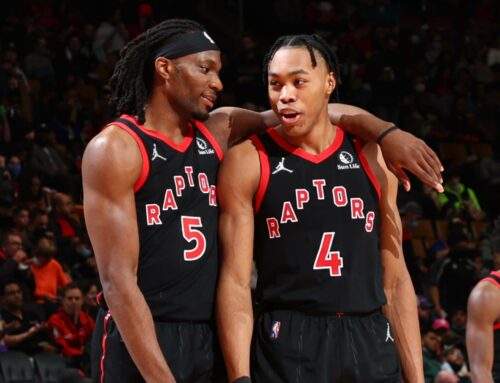I spoke to an Assistant Coach of a Canadian University team the other day, and he asked me the simplest of questions:
“What is the best shot in basketball?”
What would your answer have been? I first thought the obvious: a lay-up from a slight angle.
Then I reconsidered: this guy’s sophisticated. Maybe it’s something favoured by the analytics department and more nuanced like a two-footer from the charge circle.
Or maybe it was a free-throw and he was alluding to attacking the rim (the wrong answer, but a good sentiment to keep in mind all the same).
They were all wrong. It was a trick question, in my opinion.
He was not asking WHERE the best shot is but WHAT is the best shot.
Answer: the best shot on the floor is the most open one.
Which is like, duh. But also something that, for some players, gets lost when overthinking the game: making too many moves or playing too rigidly to coach’s instructions.
Sometimes we forget to fulfill the most fundamental task in basketball: shoot when open.
Sidenote: You will always be a greater liability to your team not shooting a wide-open shot than shooting it. The trick is being in the right spot.
Then I was listening to a podcast talking about NBA injuries and the host remarked that “sometimes availability is the best ability” referring to players’ injuries and court time.
And it got me thinking about those two concepts: being open and being available.
Being open is passive. It’s a momentary state. Your defender is giving you too much space or there’s a confusion in scheme – like a breakdown in their zone – or you just straight-up run fast down the court and get a bomb pass à la Kyle Lowry to Pascal Siakam.
Availability, on the other hand, is an active goal. Creating space and opportunity to receive the ball with enough time to shoot.
I’m splitting hairs, but for shooters it’s an important distinction.
Great shooters do not need to create their own shots – though it helps. Rather, they excel at moving without the ball and making themselves available for the opportune moment.
The NBA is loaded with supremely effective basketball players who rarely, if ever, dribble the ball.
The most obvious examples for us non-90s babies were Reggie Miller and Richard “RIP” Hamilton.
Reggie was renowned for running up, down, around, and every-which-way to get open. Even if the first set failed, Reggie kept moving for a secondary or tertiary opportunity.
In the first clip, Reggie receives two screens, curls it, does not get the ball, circles back up to where he started, receives another screen, and finally hits a contested jumper.
In the second clip, Reggie takes a screen and, trickily, goes overs his teammate, but under his teammate’s defender, only to bounce off that dude’s major girth, return for another screen, and snipe another contested shot. WHOOF! I am tired just watching all that.
RIP was a bit different than Reggie in that his range never extended beyond 18-20 feet. He averaged 1.5 three-point attempts for his career and shot a meh 35%.
Here’s RIP sticking it to his predecessor, Sir Reggie, in the same fashion. Though it ends in a slash to the rim.
For the younger readers, Klay Thompson is king. Nothing epitomizes making yourself available more than the night Klay scored 60 points on…11…dribbles…
The following clip shows Klay at his best in three different shots. The first is clearly a set play with a devastating back screen by Draymond Green. Watch how Klay sets his defender up for death-by-elbows. On the second, the Klay and Steph Curry hive-mind watch each other the entire time, waiting for that available moment. The third is nothing special – even though it’s totally special – except that he reads exactly how to use the screens by the way his defenders follow and switch – as he does all the time.
Sure, these examples are all qualified by the fact that these players are extremely athletic, dead-eye shooters. But they reveal to all of us how this game can be played without any one player having to over dribble.
What is Off-Ball Movement
Quick chat on the basics.
1. Screening Away
This is my favourite trick in the book. Defenders are always more concerned with the Screenee than the Screener. For that reason, as a Shooter, I prefer to do the screening more than being screened.
That way, the attention is off me.
If they switch I roll to the basket. If they double or hedge, I pop to the three-point line and wait for the Screenee to attack and kick.
2. Cutting
I will save the types of cuts for another article. But the only thing that gives a basketball-junky like me more satisfaction than watching a fantastic passer is witnessing the art of cutting. It is the total package of athleticism, intelligence, and discipline.
Cutting can be with a screen or without one. What matters is what you do with them and how you read the court.
Reading the court – where your defender, your teammates, and your teammates’ defenders are positioned – is like figuring out when to jay-walk on a bustling street. You have to anticipate everything and time your moves exactly right. Do I backdoor, or curl, or fade, or go through?
One false move and *SMACK*.
How to Make Yourself Available
1. Change of Speed
Running around at full speed is not always the best way to get open. Sometimes you want to lull your defender into a false sense of security and then explode around a screen or step one way and then sprint the other. You gotta mix it up.
2. Finding Space
Similar to what we discussed above, finding space means getting to an empty spot and making yourself available, where your teammate can find you.
If you are wide open at the top of the three-point line, but your teammate is in front of you driving to the hoop, how will they know you are open let alone get you the ball?
Finding space means finding lines of sight for others to see you and hit you with the pass.
3. Watch Your Defender
Great players move on the court not according to where they want to go but to what their defender is doing. You saw the Greats do this in the clips above. They are always adapting. The first time a defender does one thing, but the second time does something else. It progressively gets more and more complicated as both you and your defender try to figure each other out.
You need to be constantly analyzing your defender’s behavior, and, eventually, the behaviors of the other defenders on the court. Are they following you or denying you? Are they aggressive or conservative? Are they going over screens or under them?
All of these different characteristics dictate how you move off screens and cut on and off the ball. It is also where tricksters and tacticians thrive and where the real fun begins!
4. Don’t Stop Moving
The fitter you are the more you can move. The more you move the less predictable you are. The less predictable you are the harder you are to defend.
∴Get in top shape.
5. Trust Your Teammates
What goes around comes around. It’s a life mantra and a basketball mantra. You gotta give up the ball to get the ball.
Players have trouble trusting their teammates to give back the ball. What is lost on most ball-hungry players is that passing the ball actually benefits them later on when they have the ball again. Their defender might be off-balance and other defenders likely less capable of helping.
The basketball travels more quickly passing than dribbling. You also move more quickly without the ball than dribbling it. Therefore, you and the ball can get to a single space more quickly apart than you can together.
~
I suppose I should have admitted this earlier, but I write this article with complete bias – my dribbling skills are modest. I depend on intelligent passers to find me after all my hardwork moving off-ball.
And that is the rub. If you do not have teammates who know to look for you, your hardwork goes unrewarded.
Conversely, real basketball players and serious coaches will A-L-W-A-Y-S recognize players who bust their ass on offense and defense. Every team needs players who unselfishly move for others.
As we saw with Reggie, Klay, RIP, and many others you can be a historically great scorer without ever having to handle the ball.





